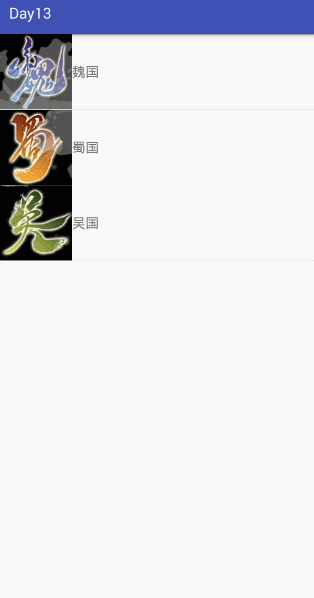Android 中使用ExpandableListView 实现分组
一个视图显示垂直滚动两级列表中的条目。这不同于列表视图,允许两个层次,类似于QQ的好友分组。要实现这个效果的整体思路为:
1.要给ExpandableListView 设置适配器,那么必须先设置数据源。
2.数据源,就是此处的适配器类,此方法继承了BaseExpandableListAdapter,它是ExpandableListView的一个子类。需要重写里面的多个方法。方法的意思,代码中都有详细的注释。数据源中,用到了自定义的View布局,此时根据自己的需求,来设置组和子项的布局样式。getChildView()和getGroupView()方法设置自定义布局。
3.数据源设置好,直接给ExpandableListView.setAdapter()即可实现此收缩功能。
下面是我自己简单做的一个显示效果:

layout中主视图expandable_layout.xml(ExpandableListView布局):
<"1.0" encoding="utf-8"?> <LinearLayout xmlns:android="http://schemas.android.com/apk/res/android" android:orientation="vertical" android:layout_width="match_parent" android:layout_height="match_parent"> <ExpandableListView android:layout_width="match_parent" android:layout_height="match_parent" android:id="@+id/el"> </ExpandableListView> </LinearLayout>
Layout中group_layout.xml(分组组名展示布局):
<"1.0" encoding="utf-8"?> <LinearLayout xmlns:android="http://schemas.android.com/apk/res/android" xmlns:app="http://schemas.android.com/apk/res-auto" android:orientation="horizontal" android:layout_width="wrap_content" android:layout_height="wrap_content" android:gravity="center_vertical"> <ImageView android:layout_width="wrap_content" android:layout_height="wrap_content" app:srcCompat="@mipmap/ic_launcher" android:id="@+id/iv_group" /> <TextView android:text="TextView" android:layout_width="wrap_content" android:layout_height="wrap_content" android:id="@+id/tv_group" /> </LinearLayout>
Layout中child_layout.xml(子菜单item布局):
<"1.0" encoding="utf-8"?> <LinearLayout xmlns:android="http://schemas.android.com/apk/res/android" xmlns:app="http://schemas.android.com/apk/res-auto" android:orientation="horizontal" android:layout_width="wrap_content" android:layout_height="wrap_content" android:gravity="center_vertical" android:paddingLeft="50dp"> <ImageView android:layout_width="wrap_content" android:layout_height="wrap_content" app:srcCompat="@mipmap/ic_launcher" android:id="@+id/iv_item" /> <TextView android:text="TextView" android:layout_width="wrap_content" android:layout_height="wrap_content" android:id="@+id/tv_item" /> </LinearLayout>
Layout中alertdialog_layout.xml(AlertDialog自定义显示布局):
<"1.0" encoding="utf-8"?> <LinearLayout xmlns:android="http://schemas.android.com/apk/res/android" android:orientation="vertical" android:layout_width="match_parent" android:layout_height="match_parent"> <EditText android:layout_width="match_parent" android:layout_height="wrap_content" android:id="@+id/et" android:hint="请输入想对他说的话"/> </LinearLayout>
Activity中Java实现代码(ExpandableListViewDemo.java):
import android.content.DialogInterface; import android.os.Bundle; import android.support.annotation.Nullable; import android.support.v7.app.AlertDialog; import android.support.v7.app.AppCompatActivity; import android.view.View; import android.view.ViewGroup; import android.widget.BaseExpandableListAdapter; import android.widget.ExpandableListView; import android.widget.ImageView; import android.widget.TextView; import android.widget.Toast; /** * Created by panchengjia on 2016/12/2. */ public class ExpandableListViewDemo extends AppCompatActivity { ExpandableListView el; //定义分组名以及对应的图片数组,需一一对应 String[] country={"魏国","蜀国","吴国"}; int[] icon={R.mipmap.wei,R.mipmap.shu,R.mipmap.wu}; //使用二维定义组内成员以及对应头像,同样需要以一一对应 String[][] heros={{"司马懿","郭嘉","夏侯惇","甄姬"},{"刘备","赵云","张飞"},{"孙权","周瑜"}}; int[][] icons={{R.mipmap.simayi,R.mipmap.guojia,R.mipmap.xiahoudun,R.mipmap.zhenji}, {R.mipmap.liubei,R.mipmap.zhaoyun,R.mipmap.zhangfei},{R.mipmap.sunquan,R.mipmap.zhouyu}}; @Override protected void onCreate(@Nullable Bundle savedInstanceState) { super.onCreate(savedInstanceState); setContentView(R.layout.expandable_layout); el= (ExpandableListView) findViewById(R.id.el); //设置点击下拉子菜单的监听事件 el.setOnChildClickListener(new ExpandableListView.OnChildClickListener() { @Override public boolean onChildClick(ExpandableListView parent, View v, int groupPosition, int childPosition, long id) { //获取分组成员的姓名 TextView tv = (TextView) v.findViewById(R.id.tv_item); String name = tv.getText().toString(); //调用show方法(自定义AlertDialog) show(v,name); return false; } }); el.setAdapter(new MyAdapter());//设置自定义适配器 } //定义show方法调出AlertDialog(不再赘述,详情请看前期相关博文,文章末尾有链接) public void show(View v,String name){ AlertDialog.Builder builder = new AlertDialog.Builder(this); builder.setTitle(name);//设置标题名为传入的字符串(分组内点击对应的人物名) View msg = getLayoutInflater().inflate(R.layout.altertdialog_layout,null); builder.setView(msg); builder.setPositiveButton("确定", new DialogInterface.OnClickListener() { @Override public void onClick(DialogInterface dialog, int which) { Toast.makeText(ExpandableListViewDemo.this, "已发送", Toast.LENGTH_SHORT).show(); } }); builder.setNegativeButton("取消", new DialogInterface.OnClickListener() { @Override public void onClick(DialogInterface dialog, int which) { Toast.makeText(ExpandableListViewDemo.this, "不想说了", Toast.LENGTH_SHORT).show(); } }); builder.show(); } //设置自定义适配器 class MyAdapter extends BaseExpandableListAdapter{ //获取国家个数 @Override public int getGroupCount() { return country.length; } //获取每个国家对应的人数 @Override public int getChildrenCount(int groupPosition) { return heros[groupPosition].length; } //获取对应国家名 @Override public Object getGroup(int groupPosition) { return country[groupPosition]; } //获取对应国家对应的任务 @Override public Object getChild(int groupPosition, int childPosition) { return heros[groupPosition][childPosition]; } //获取选择的国家对应数组下标 @Override public long getGroupId(int groupPosition) { return groupPosition; } //获取选择的任务对应数组下标 @Override public long getChildId(int groupPosition, int childPosition) { return childPosition; } //表示人物和国家ID是否稳定的更改底层数据 @Override public boolean hasStableIds() { return true; } //获取一个视图显示国家名以及对应的图标(ListView适配器优化) @Override public View getGroupView(int groupPosition, boolean isExpanded, View convertView, ViewGroup parent) { ViewHolder vh; if(convertView==null){ convertView=getLayoutInflater().inflate(R.layout.group_layout,null); vh=new ViewHolder(); vh.tv= (TextView) convertView.findViewById(R.id.tv_group); vh.iv= (ImageView) convertView.findViewById(R.id.iv_group); convertView.setTag(vh); } vh= (ViewHolder) convertView.getTag(); vh.tv.setText(country[groupPosition]); vh.iv.setImageResource(icon[groupPosition]); return convertView; } //获取一个视图显示国家对应人物以及对应的图标(ListView适配器优化) @Override public View getChildView(int groupPosition, int childPosition, boolean isLastChild, View convertView, ViewGroup parent) { ViewHolder vh; if(convertView==null){ convertView=getLayoutInflater().inflate(R.layout.child_layout,null); vh=new ViewHolder(); vh.tv= (TextView) convertView.findViewById(R.id.tv_item); vh.iv= (ImageView) convertView.findViewById(R.id.iv_item); convertView.setTag(vh); } vh= (ViewHolder) convertView.getTag(); vh.tv.setText(heros[groupPosition][childPosition]); vh.iv.setImageResource(icons[groupPosition][childPosition]); return convertView; } class ViewHolder{ ImageView iv; TextView tv; } //设置子选项(对应人物)是可选的 @Override public boolean isChildSelectable(int groupPosition, int childPosition) { return true; } } }
补充说明:
java实现代码中用到自定义适配器ListView的优化,优化步骤如下:
(1)使用固定宽高(match_parent)的ListView,有助于在填充item(ListView中每行的布局)时避免重复渲染ListView组件,导致重复多次调用getView方法。
(2)Convertview用来重复使用已被隐藏的item对象,从而避免重复创建每个item的view对象。
(3)使用ViewHolder优化提高容器中查找组件的效率。
感谢阅读,希望能帮助到大家,谢谢大家对本站的支持!


